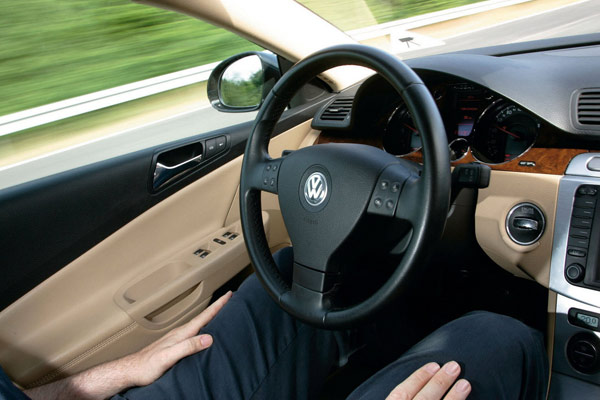Volkswagen has developed a new temporary autopilot system for cars called TAP, which Volkswagen describes as a semi automatic driving mode that will drive your car at the speed you have selected and also keep you at a safe distance from the vehicle in front of you, system is capable of reducing the vehicles speed before a bend, and is also designed to maintain the cars central position within the lane markers. Another capability of this system is observing lane rules and speed limits and also it’s a semi-automatic system so you need to continually monitor the car, but you really shouldn’t be napping while the car is flying down the highway at 75MPH……….
At the final presentation of the EU research project HAVEit (Highly Automated Vehicles for Intelligent Transport), Prof. Dr. Jürgen Leohold, Executive Director Volkswagen Group Research is presenting the Temporary Auto Pilot by Volkswagen, which is monitored by the driver, the car can drive semi-automatically up to a speed of 130 kilometres per hour on motorways. It represents a link between today’s assistance systems and the vision of fully automatic driving. “Above all, what we have achieved today is an important milestone on the path towards accident-free car driving,” emphasises Leohold at final presentation of the EU research project HAVEit in the Swedish city of Borås. The Temporary Auto Pilot (TAP) bundles semi-automatic functions, i.e. functions monitored by the drive, with other driver assistance systems. It combines such automatic systems as ACC adaptive cruise control, the Lane Assist lane-keeping system and Side Assist lane-changing monitoring into one comprehensive function. “Nonetheless, the driver always retains driving responsibility and is always in control,” continues Leohold. “The driver can override or deactivate the system at any time and must continually monitor it.”
AP always offers the driver an optimal degree of automation as a function of the driving situation, acquisition of the surroundings and driver and system states. It is intended to prevent accidents due to driving errors by an inattentive, distracted driver. In the semi-automatic driving mode referred to as Pilot Mode for short, TAP maintains a safe distance to the vehicle ahead, drives at a speed selected by the driver, reduces this speed as necessary before a bend, and maintains the vehicle’s central position with respect to lane markers. The system also observes overtaking rules and speed limits. Stop and start driving manoeuvres in traffic jams are also automated. With TAP, it is possible to drive at speeds of up to 130 kilometres per hour on motorways or similar roads. Drivers must still continually focus their attention on the road, so that they can intervene in safety-critical situations at any time. In contrast to previous research vehicles such as “Junior” and “Stanley“, TAP is based on a relatively production-like sensor platform, consisting of production-level radar, camera and ultrasonic-based sensors supplemented by a laser scanner and an electronic horizon. “One conceivable scenario for its initial use might be in monotonous driving situations, e.g. in traffic jams or over sections of a driving route that are exceedingly speed-limited,” comments Leohold.
[ttjad keyword=”auto”]




